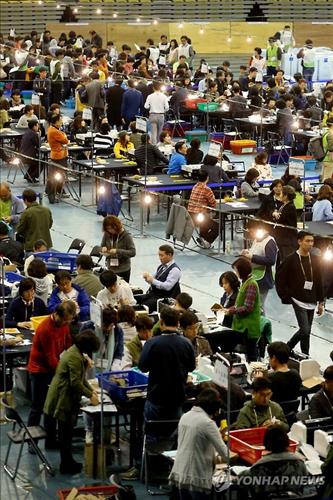- California Assembly OKs highest minimum wage in nation
- S. Korea unveils first graphic cigarette warnings
- US joins with South Korea, Japan in bid to deter North Korea
- LPGA golfer Chun In-gee finally back in action
- S. Korea won’t be top seed in final World Cup qualification round
- US men’s soccer misses 2nd straight Olympics
- US back on track in qualifying with 4-0 win over Guatemala
- High-intensity workout injuries spawn cottage industry
- CDC expands range of Zika mosquitoes into parts of Northeast
- Who knew? ‘The Walking Dead’ is helping families connect
Voter turnout in parliamentary elections hovers below 60 pct
SEOUL, April 14 (Yonhap) — Just less than 60 percent of South Korean voters cast their ballots to elect new lawmakers, the national election watchdog said Thursday.
More than 24.4 million out of over 42.1 million, or 58. percent, went to 13,837 polling stations across the country to elect a new 300-member National Assembly on Wednesday, said the National Election Commission (NEC).
The official voter turnout is higher than the previous general elections in 2012 when 54.2 percent was recorded, the NEC said.
It also marks the highest turnout in 12 years since 63.9 percent was recorded in the parliamentary elections in 1996.
Election officials attributed the higher-than-expected voter turnout to the highest voter turnout of an early voting that took place last week.
During the two-day early voting period from Friday to Saturday, 5.13 million voters, or 12.2 percent, cast their ballots at more than 3,000 polling stations.
“People’s attention to politics was very high during the 19th general elections four years ago as it took place just before the presidential election,” said an NEC official on the condition of customary anonymity, attributing to the effect of the early voting.
The early voting system, adopted in the 2013 by-elections, is different from absentee voting in that it does not require voters to sign up in advance. Eligible voters can simply show up at a polling station during the pre-voting period and cast their ballots.
Election officials forecast that the voter turnout could reach 60 percent during the next parliamentary elections four years later if more people are aware of the early voting system.
The total turnout rate also includes the results of overseas voting that took place earlier this month in 113 countries worldwide,
A total of 63,797 out of 154,217 registered overseas Koreans participated in the six-day poll, resulting in a turnout of 41.4 percent.
By region, South Jeolla Province saw the highest voter turnout of 63.7 percent, followed by the administrative city of Sejong, with 63.5 percent.
The southeastern industrial city of Daegu recorded the lowest voter turnout with 54.8 percent, trailed by the southern port city of Busan with 55.4 percent, the NEC said.
The capital city of Seoul and its surrounding areas, which are forecast to be closely contested, saw a preliminary voter turnout of 59.8 percent.
Political and survey analysts say Wednesday’s voter turnout affected the outcome of the polls since a higher turnout usually means more young voters participated in the balloting.
The opposition parties are traditionally more popular among younger voters, while older voters are more supportive of the conservative ruling party.
During the 2004 parliamentary elections, the then-liberal party took the sweeping victory when the turnout rate was 60.6 percent.
Meanwhile, the predecessor of the ruling Saenuri Party won the next elections in 2008 when the turnout rate marked 46.1 percent.












